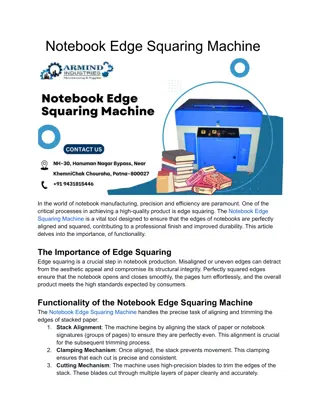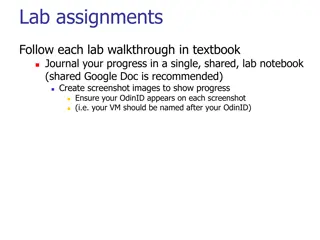Our Beautiful Stinky Friends Digital Lab Notebook
Comprehensive guide on using a digital lab notebook for experimental days, detailing materials, methods, initial results, and methods for tracking microbial activity during fermentation. Includes description and images for each section to aid in organizing and documenting laboratory experiments effectively.
Download Presentation

Please find below an Image/Link to download the presentation.
The content on the website is provided AS IS for your information and personal use only. It may not be sold, licensed, or shared on other websites without obtaining consent from the author. Download presentation by click this link. If you encounter any issues during the download, it is possible that the publisher has removed the file from their server.
E N D
Presentation Transcript
Our Beautiful Stinky Friends Digital Lab Notebook
How to Use the Digital Lab Notebook This document is to be used during each experimental day. It is designed to be a living log of what you want to do, what you did, and what you learned from the day. It should be filled out as you work and/or immediately after the lab. The information you collect here will help you write each of the four sections of a lab report.
Materials and Methods What exact materials will you use to conduct your experiment? What steps made up your procedure? You can choose to adapt the Fermented Vegetable Recipe Example.
Initial Results Describe your jar before the fermentation begins. This can include descriptions of: The appearance and smells of the liquid and the vegetables. What the vegetables felt like when you were mixing them with the salt. Anything you noticed happened in the first few minutes of the vegetables reacting in the jar. Include a picture of the fermentation here. Describe your fermentation here.
Method #1: Bubble Counting - Results Date Bubbles Since the fermentation naturally produces gases, you can assume that bubbles mean microbial activity. It s going to be impossible to count every bubble, but you can use a marker to count gas production in a small area. Draw a circle 2 inches in diameter on the jar where you see bubbles collecting. Check in every day or two to count the bubbles in the circle. Add more rows if needed
Method #2: Water Level - Results Date Changes In Water Level As we saw in the videos of fermentations, the water levels within the jar will change. This is due to both the dehydrating powers of salt and the production of water as a byproduct in one of the chemical reactions occurring in the jar. You can measure the water levels by putting a thin rubber band at the water level. Check every day or two to see how the water has dropped or increased by using a ruler to measure the changes. Add more rows if needed
Method #3: pH Changes - Results There are several key chemical reactions that are occurring within the jar. One of them produces lactic acid, which can alter the pH of the salt water. While the fermentation proceeds, the pH will decrease as the microbes perform the reactions. To record the pH, use a sterile toothpick or clean utensil to dip into the fermentation vessel and transfer one or two drops of the liquid to a pH strip. Follow the color guide provided by the manufacturer to identify the acidity of the ferment. pH Date Add more rows if needed
Why Does Fermentation Happen? Callout Question Answer Sheet 1. What chemical forms the bubbles in your fermentation? 2. What chemical reaction is producing the bubbles? 3. How does the amount of anaerobic or aerobic respiration affect the taste of fermented food?
What Does Your Fermentation Taste Like? Date Flavor Notes Salty, Sour, Sweet, Bitter, Umami Add more rows if needed























